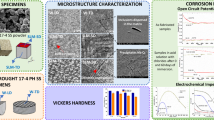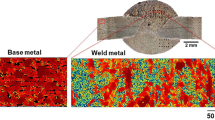Abstract
The objective of this work was to understand the influence of grain size on solid impingement erosion behavior characterized by deformation at high strain rates and large strains. Experiments were carried out at a velocity of 40 m/s, impact angle of 90 deg with 300 to 450 μm steel shot as erodent on iron, copper, and titanium with varying grain sizes. The results indicate that the erosion rate is independent of grain size in iron and copper while it is apparently grain size dependent in titanium. The results are rationalized in terms of the negligible contribution of the Hall-Petch component to the flow stress at large strains in the case of copper and iron. The decreasing erosion rate in titanium with increasing grain size was due to the increased interstitial content picked up during thermal treatment and consequent increase in strain hardening and strain rate hardening and not due to increased grain sizeper se. Adiabatic shear bands were observed in coarse-grained iron under actual erosion conditions.
Similar content being viewed by others
References
W. Tabakoff and A. Hamed: Proc. 6th Int. Conf. on Erosion by Liquid and Solid Impact, Cambridge University, U. K., 1984, paper 54.
D. Mills, J. S. Mason, and K. N. Tong: Proc. 6th Int. Conf. on Erosion by Liquid and Solid Impact, Cambridge University, U.K., 1984, paper 58.
A. V. Levy and S. Jahanmir:Corrosion-Erosion Behavior of Materials, K. Natesan, ed., Metallurgical Society of AIME, New York, NY, 1980, pp. 177–89.
T. Foley and A. Levy:Wear, 1983, vol. 91, pp. 45–64.
L. P. McCabe, G. A. Sargent, and H. Conrad:Wear, 1985, vol. 105, pp. 257–77.
M. Emiliani and R. Brown:Wear, 1984, vol. 94, pp. 323–38.
J. Salik, D. Buckley, and W. A. Brainard:Wear, 1981, vol. 65, pp. 351–58.
C. M. Preece, S. Vaidya, and S. Dakshinamoorthy:Erosion: Pre-vention and Useful Applications, ASTM STP 664, W.F. Adler, ed., ASTM, 1979, pp. 409-33.
A. Venugopal Reddy and G. Sundararajan:Wear, 1985, vol. 103, pp. 133–48.
H. Mecking:Strength of Metals and Alloys, vol. 3,Proceedings of5th Int. Conf., Aachen, Federal Republic of Germany, P. Haasen, V. Gerold, and G. Kostorz, eds., Pergamon Press, 1980, pp. 1573–94.
A. Venugopal Reddy, G. Sundararajan, R. Sivakumar, and P.Rama Rao:Acta Metall., 1984, vol. 32, pp. 1305–16.
G. Sundararajan:Trans, of Ind. Inst, of Metals, 1983, vol. 36, pp. 474–94.
G. Sundararajan and P. G. Shewmon:Acta Metall., 1983, vol. 31, pp. 101–09.
Niels Hansen:Metall. Trans. A, 1985, vol. 16A, pp. 2167–90.
R. W. Armstrong: “Yield, Flow and Fracture of Polycrystals,” T. N. Baker, ed.,Applied Science, 1983, pp. 1-31.
A. W. Thompson:Work Hardening in Tension and Fatigue, A. W. Thompson, ed., ASME, 1977, pp. 89-127.
M. F. Ashby:Stengthening Methods in Crystals, A. Kelly and R.B. Nicholson, eds., Wiley, New York, NY, 1971, pp. 137–92.
A. W. Thompson, M. I. Baskes, and W. G. Flanagan:Acta Metall., 1973, vol. 21, pp. 1017–28.
H. Dong and A. W. Thompson:Metall. Trans. A, 1985, vol. 16A, pp. 1025–30.
J. Gil Sevillano, P. Van Houtte, and E. Aernoudt:Progress in Mate-rials Science, J. W. Christian, P. Haasen, and T. B. Massalski, eds., Pergamon Press, New York, NY, 1982, vol. 25, pp. 69–411.
I. Finnie:Proc. 3rd U.S. Natl. Congr. of Applied Mechanics, ASME, New York, NY, 1958, pp. 527–32.
I. M. Hutchings:Wear, 1981, vol. 70, pp. 269–81.
H. Conrad, M. Doner, and B. de Meester:Titanium Science and Technology, R. I. Jaffee and H. M. Burte, eds., Plenum Press, New York, NY, 1973, vol. 2, pp. 969–1005.
H. Conrad, B. de Meester, M. Doner, and K. Okazaki:Physics of Solid Solution Strengthening, E. W. Collings and H. L. Gregel, eds., Plenum Press, New York, NY, 1975, pp. 1–45.
R. E. Winter and I. M. Hutchings:Wear, 1975, vol. 34, pp. 141–48.
S. P. Timothy and I. M. Hutchings: Proceedings of 6th International Conference on Erosion by Liquid and Solid Impact, Cambridge Uni-versity, U.K., 1983, paper 43.
T. Christman and P. G. Shewmon:Wear, 1979, vol. 52, pp. 57–70.
H. C. Rogers:Ann. Rev. Mat. Sei., 1979, vol. 9, pp. 283–311.
D. Peirce, R. J. Asar, and A. Needleman:Acta Metall., 1982, vol. 30, pp. 1087–1119.
G. Sundararajan:Proceedings of the 6th Int. Conf. on Fracture, New Delhi, Pergamon Press, 1984, vol. 5, pp. 3119–26.
Author information
Authors and Affiliations
Rights and permissions
About this article
Cite this article
Reddy, A.V., Sundararajan, G. The influence of grain size on the erosion rate of metals. Metall Trans A 18, 1043–1052 (1987). https://doi.org/10.1007/BF02668553
Received:
Published:
Issue Date:
DOI: https://doi.org/10.1007/BF02668553




